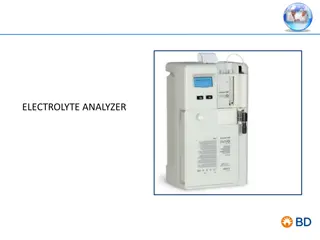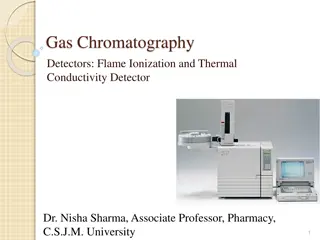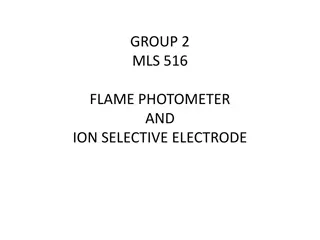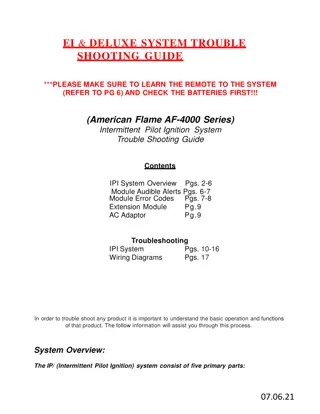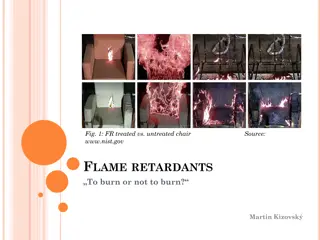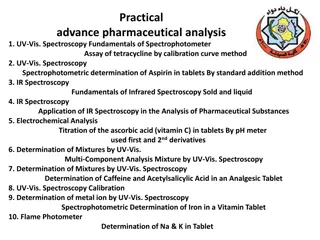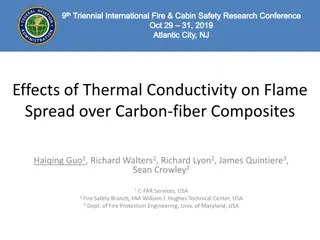
Flame Photometry: Definition, Principle, Procedure & Applications
"Learn about flame photometry, a branch of atomic absorption spectroscopy, used for analyzing metal ions in analytical chemistry. Explore the principle of flame photometry, its parts, procedure, and applications in this comprehensive guide."
Download Presentation

Please find below an Image/Link to download the presentation.
The content on the website is provided AS IS for your information and personal use only. It may not be sold, licensed, or shared on other websites without obtaining consent from the author. If you encounter any issues during the download, it is possible that the publisher has removed the file from their server.
You are allowed to download the files provided on this website for personal or commercial use, subject to the condition that they are used lawfully. All files are the property of their respective owners.
The content on the website is provided AS IS for your information and personal use only. It may not be sold, licensed, or shared on other websites without obtaining consent from the author.
E N D
Presentation Transcript
StudyMafia.Org Flame Photometry Submitted To: Submitted By: Studymafia.org Studymafia.org
Table Contents Definition Introduction Principle of Flame Photometry Parts of Flame Photometry Procedure of Flame Photometry Process in Flame Photometry Conclusion 2
Definition Flame photometry is one of the branches of atomic absorption spectroscopy. It is also known as flame emission spectroscopy. Currently, it has become a necessary tool in the field of analytical chemistry. 3
Introduction Flame photometer can be used to determine the concentration of certain metal ions like sodium, potassium, lithium, calcium and cesium etc. In flame photometer spectra the metal ions are used in the form of atoms. The International Union of Pure and Applied Chemistry (IUPAC) Committee on Spectroscopic Nomenclature has named this technique as flame atomic emission spectrometry (FAES). 4
Principle of Flame Photometry The compounds of the alkali and alkaline earth metals (Group II) dissociate into atoms when introduced into the flame. Some of these atoms further get excited to even higher levels. But these atoms are not stable at higher levels. And the light emitted is in turn proportional to the concentration of the sample. 6
Principle of Flame Photometry Hence, these atoms emit radiations when returning back to the ground state. These radiations generally lie in the visible region of the spectrum. Each of the alkali and alkaline earth metals has a specific wavelength. The intensity of the emission is directly proportional to the number of atoms returning to the ground state. 7
Parts of Flame Photometry Source of flame: A Burner in the flame photometer is the source of flame. It can be maintained in at a constant temperature. The temperature of the flame is one of the critical factors in flame photometry. 9
Parts of Flame Photometry Nebuliser: Nebuliser is used to send homogeneous solution into the flame at a balanced rate. Optical system: The optical system consists of convex mirror and convex lens. The convex mirror transmits the light emitted from the atoms. Convex mirror also helps to focus the emissions to the lens. 10
Parts of Flame Photometry Simple colour filters: The reflections from the mirror pass through the slit and reach the filters. Filters will isolate the wavelength to be measured from that of irrelevant emissions. 11
Parts of Flame Photometry Photo-detector: The intensity of radiation emitted by the flame is measured by photo detector. Here the emitted radiation is converted to an electrical signal with the help of photo detector. These electrical signals are directly proportional to the intensity of light. 12
Procedure of Flame Photometry Both the standard stock solution and sample solution are prepared in fresh distilled water. The flame of the photometer is calibrated by adjusting the air and gas. Then the flame is allowed to stabilize for about 5 min. Now the instrument is switched on and the lids of the filter chamber are opened to insert appropriate colour filters. 13
Procedure of Flame Photometry The readings of the galvanometer are adjusted to zero by spraying distilled water into the flame. The sensitivity is adjusted by spraying the most concentrated standard working solution into the flame. Now the full scale deflection of the galvanometer is recorded. 14
Procedure of Flame Photometry Again distilled water is sprayed into the flame to attain constant readings of galvanometer. Then the galvanometer is readjusted to zero. Now each of the standard working solutions is sprayed into the flame for three times and the readings of galvanometer are recorded. After each spray, the apparatus must be thoroughly washed. 15
Procedure of Flame Photometry Finally sample solution is sprayed into the flame for three times and the readings of galvanometer are recorded. After each spray, the apparatus must be thoroughly washed. Calculate the mean of the galvanometer reading. ] 16
Process in Flame Photometry Desolvation: Desolvation involves drying a sample in a solution. The metal particles in the solvent are dehydrated by the flame and thus solvent is evaporated. Vaporization: The metal particles in the sample are also dehydrated. This also led to the evaporation of the solvent. 17
Process in Flame Photometry Atomization: Atomization is the separation of all atoms in a chemical substance. The metal ions in the sample are reduced to metal atoms by the flame. Excitation: The electrostatic force of attraction between the electrons and nucleus of the atom helps them to absorb a particular amount of energy. 18
Process in Flame Photometry Emission: Since the higher energy state is unstable the atoms jump back to the ground state or low energy state to gain stability. This jumping of atoms emits radiation with characteristic wavelength. The radiation is measured by the photo detector. 19
Conclusion Flame photometry is useful for the determination of alkali and alkaline earth metals. Used in determination of lead in petrol. Used in the study of equilibrium constants involving. in ion exchange resins. 20
Thanks To StudyMafia.org



